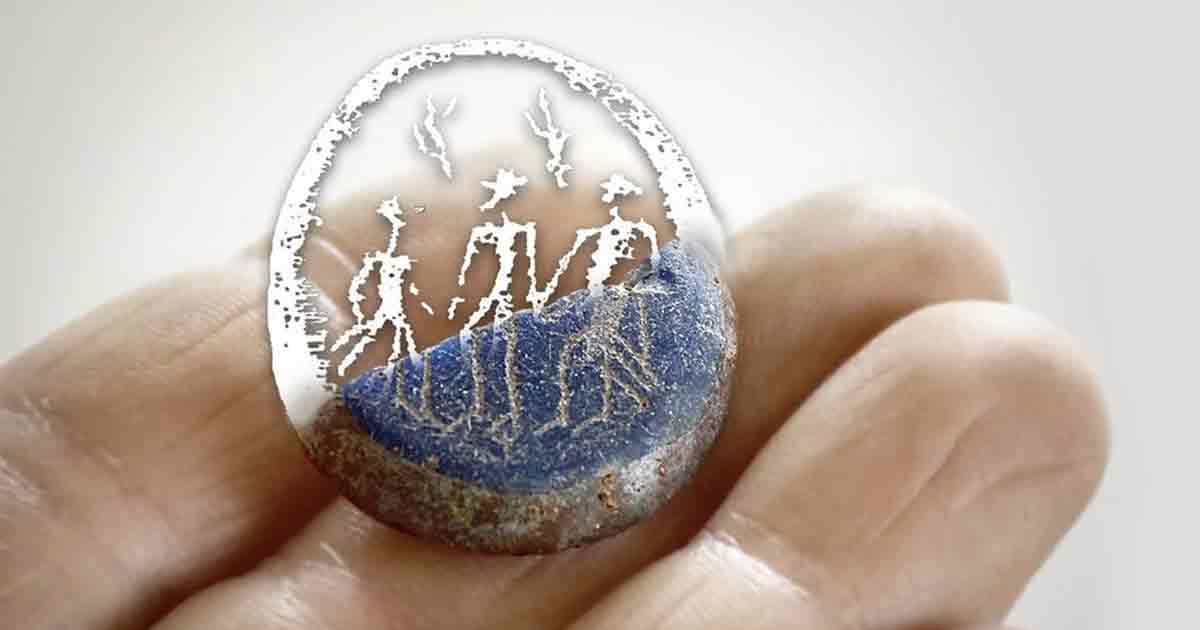30,000 Artifacts Found At Medieval Town of Kalmar, Sweden
A whopping 30,000 artifacts dating back to between 1250 and 1650 have been unearthed during excavations in medieval Kalmar, a town in southeastern Sweden. This includes a 15th-century gold ring adorned with a Christ motif, believed to have been lost approximately 500 years ago. Its petite size suggests it was worn by a woman. Similar rings with parallels have been found in other regions such as northern Finland and Östergötland.
A unique crystal amulet known as an alsengem, possibly discarded and broken, was also found during the excavations of medieval Kalmar. Alsengems, also known as pilgrim’s amulets, are small crystal stones with religious and secular significance, deriving their name from the Danish island of Als where they were initially found. They were found with three engraved figures and originated from the 13th and 14th centuries, discarded around 400 years ago. These small glass stones are often translucent or slightly opaque.

15th-century gold ring adorned with a Christ motif unearthed during excavations of medieval Kalmar. (Arkeologerna)
Revealing the Secrets of Medieval Kalmar: Uncovering Streets, Buildings and Plots
In addition, the two-year-long research and investigation has uncovered the remnants of hundreds of buildings, streets and items of daily use, amongst others, providing a window into the ways in which people lived in medieval Kalmar, as well as the evolution of their lifestyles. The archaeologists from the State Historical Museums have conducted excavations in the Old Town of Kalmar, Sweden, uncovering portions of approximately 50 medieval plots, including around ten streets and sections of the old city wall.
- The Small Swedish Town of Kalmar Has a Massive History
- This Rare Battle-Sword Just Found in Sweden Is “An Evolutionary Leap”
“The building remains and cultural layers constitute a historical archive holding enormous amounts of information and stories about the political and economic ambitions, everyday life, and living conditions of previous generations,” explained lead archaeologist Magnus Stibéus in Arkeologerna. “We get an insight into large parts of the medieval city and encounter traces of the social and economic existence of different groups; traders, craftsmen, civil servants, church people, poor and rich,” he said while describing the research conducted in relation to medieval Kalmar.
From an archaeological and historical perspective, it's highly unusual for such extensive urban areas to be thoroughly explored, let alone for these excavations to yield such remarkable findings. Other finds from medieval Kalmar include the remains of a runestone possibly from a 12th-century tombstone, as well as the imprint of a cat's paw in a brick!

Medieval Kalmar's iconic castle, Kalmar Slott, captured in stunning aerial view. (zephyr_p / Adobe Stock)
Excavations of Medieval Kalmar Reveal the Devastation Caused by War
The archaeological evidence also reflects the impact of wartime situations, specifically in the wake of the devastation caused by the Kalmar War of 1611, with burnt farms, collapsed buildings and various projectiles such as cannonballs and musket balls.
In fact, the surveys of medieval Kalmar show that virtually all farms were burned in connection with the Danes' attack by the city in the summer of 1611. This was possible to conclude due to the fire horizons and demolished buildings they uncovered.
The wide scope of the excavation project has allowed researchers to delve into different aspects of life in medieval Kalmar—stories of political, economic and social ambitions included. The findings have provided valuable insights into the diverse groups that inhabited the city, reported Arkeonews.
“We’ve been able to lift the lid on the city’s medieval past and have had the opportunity to study how people lived, what they ate and drank, and how this changed over time,” concluded Stibéus. “Archaeology becomes like a peephole into medieval history, giving us more insight into how life was hundreds of years ago.”

Illustration depicting the Kalmar War, by an unknown artist. (Public domain)
The Kalmar War: Scandinavian History’s Internal Strife
The Kalmar War, also known as the Danish-Swedish War of 1611 to 1613, was a conflict that occurred between Denmark-Norway and Sweden during the early 17th century. The war was primarily fought over territorial disputes and power struggles in the Baltic region, particularly concerning control over strategic locations such as Kalmar, a significant coastal city in southern Sweden, reported Encyclopaedia Britannica.
- The Harrowing Remains of the Battle of Visby's Medieval Massacre
- Sweden’s Mysterious Shipwrecks Found Full of Medieval Household Goods
The war erupted in 1611 when Danish forces, under the command of King Christian IV, launched a military campaign to capture Kalmar and assert Danish dominance in the region. The Danish invasion of Kalmar resulted in widespread devastation and destruction.
Historical records and archaeological evidence indicate that the Danish forces besieged the city, leading to the burning of numerous farms, buildings and other structures in the area. The current excavations have made considerable progress in revealing precisely this reality. The havoc wreaked by the war disrupted daily life, displaced families and undermined the local economy.
The Kalmar War ultimately ended in a stalemate, with neither side achieving a decisive victory. In 1613, the warring parties signed the Treaty of Knäred, which reaffirmed the status quo and restored peace between Denmark-Norway and Sweden.
Top image: Unique crystal amulet, known as an alsengem, unearthed during excavations of medieval Kalmar. Source: Arkeologerna
By Sahir Pandey
References
Altuntas, L. 7 March 2024. “Unique Gold Ring and Crystal Amulet among 30,000 Medieval Treasures Uncovered in Sweden” in Arkeonews. Available at: https://arkeonews.net/unique-gold-ring-and-crystal-amulet-among-30000-medieval-treasures-uncovered-in-sweden/
Carvajal, G. 6 March 2024. “Unique Medieval Gold Ring and Amulet Among More than 30,000 Artifacts Found in Kalmar, Sweden” in La Brújula Verde. Available at: https://www.labrujulaverde.com/en/2024/03/unique-medieval-gold-ring-and-amulet-among-more-than-30000-artifacts-found-in-kalmar-sweden/
Milligan, M. 5 March 2024. “Gold ring and glass alsengemet among 30,000 objects uncovered in Kalmar” in Heritage Daily. Available at: https://www.heritagedaily.com/2024/03/gold-ring-and-glass-alsengemet-among-30000-objects-uncovered-in-kalmar

















